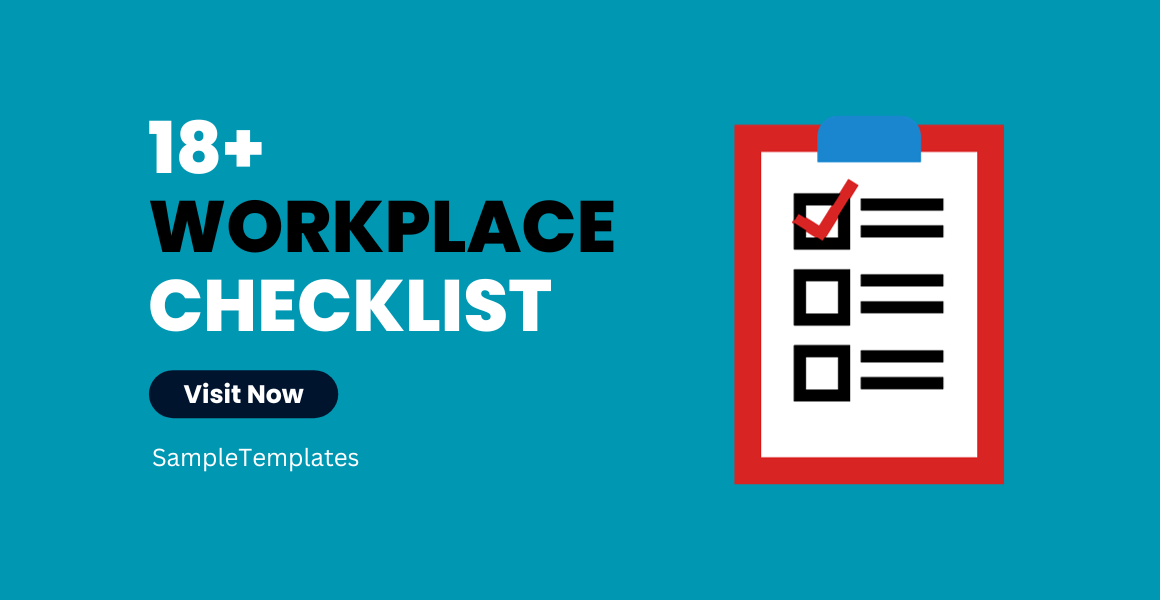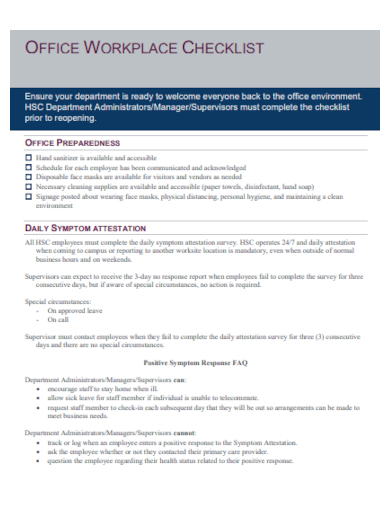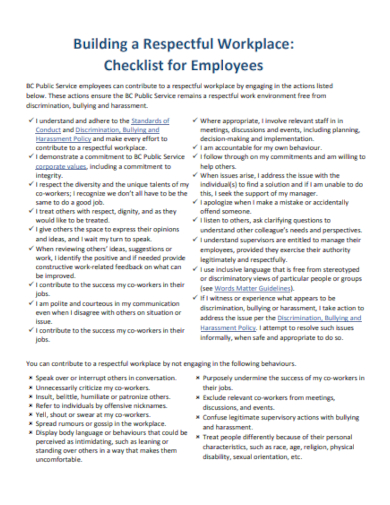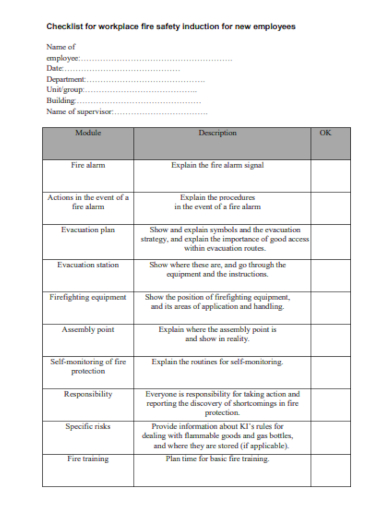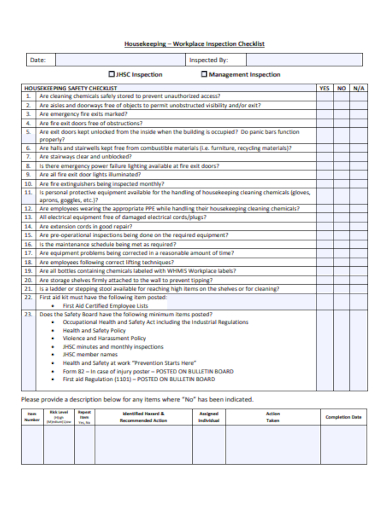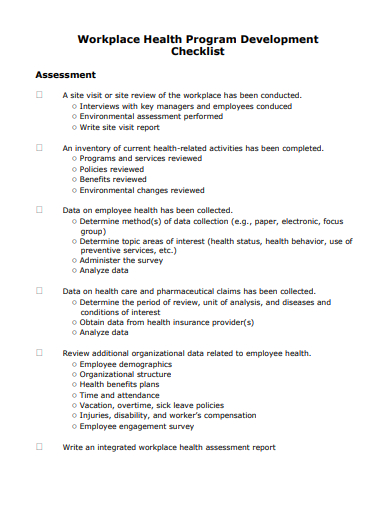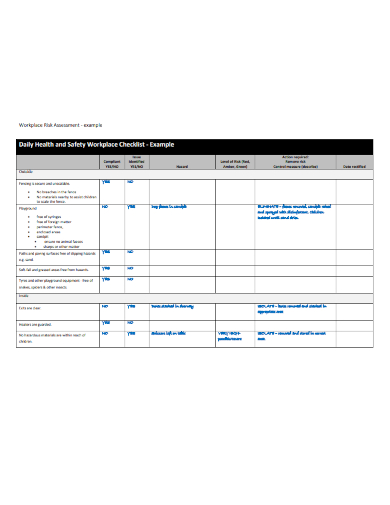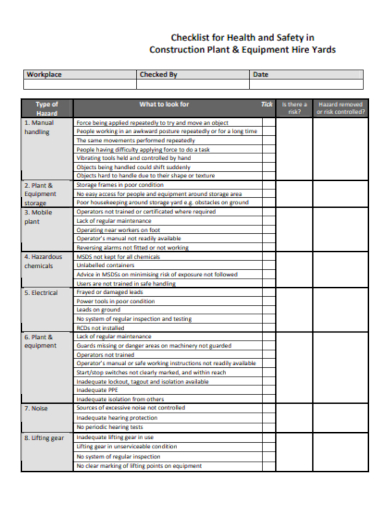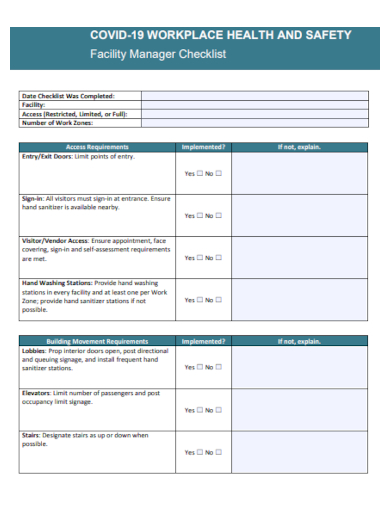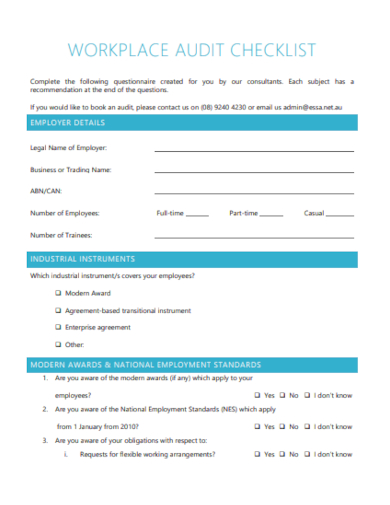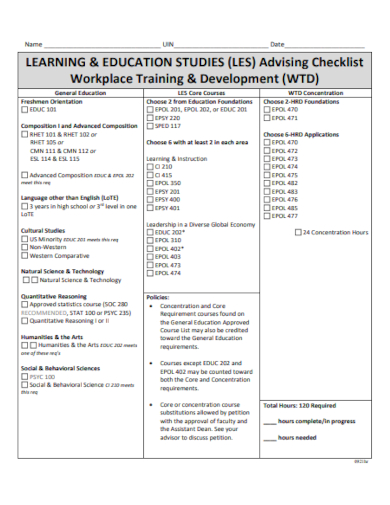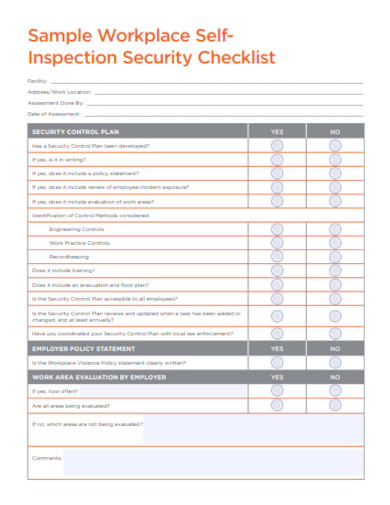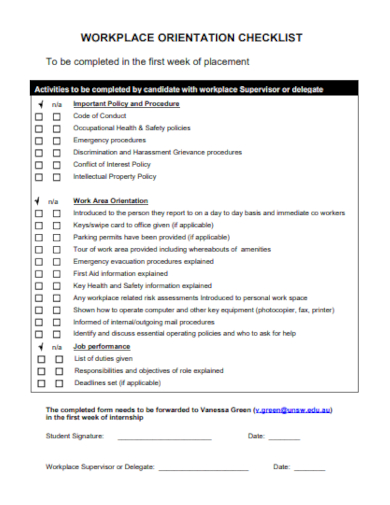Optimizing productivity and ensuring safety are pivotal in any workplace environment. Our comprehensive Workplace Checklist is meticulously crafted to address these needs, providing actionable insights and guidelines. Whether you’re managing an office, running a factory, or leading a remote team, this essential checklist is your go-to resource for fostering efficiency, compliance, and a harmonious work atmosphere. Dive in to explore practical tips and strategies that cater to diverse workplace scenarios, empowering you to create a thriving, well-organized professional space.
18+ Workplace Checklist Samples
1. Workplace Induction Checklist Template
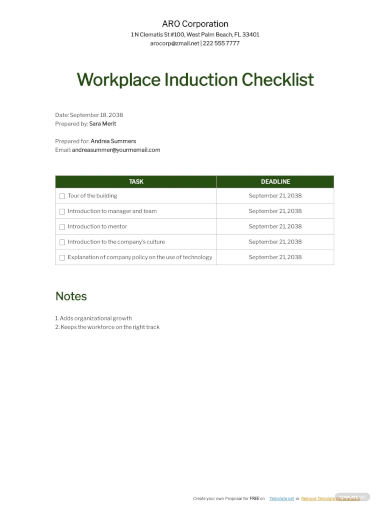
2. Workplace Safety Inspection Checklist Template

3. Sample Workplace Inspection Checklist Template
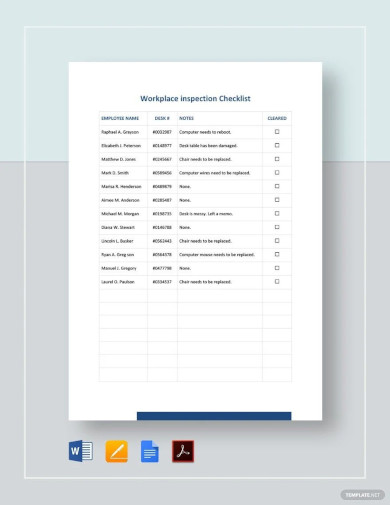
4. Sample Workplace Investigation Follow-up Checklist Template

5. Basic Checklist Template
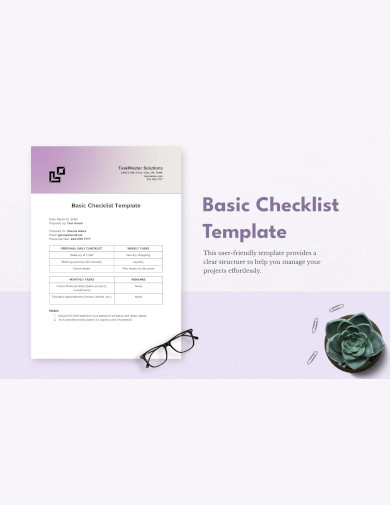
What is a Workplace Checklist?
A workplace checklist is a structured tool used by businesses and organizations to ensure that specific tasks, activities, and standards are met within the working environment. It serves various purposes, including maintaining safety, enhancing productivity, ensuring compliance with regulations, and fostering accountability among employees. By providing a clear sample outline of what needs to be done, a workplace checklist helps in organizing tasks, minimizing oversights, and facilitating smooth operations.
Importance of a Workplace Checklist
- Safety Assurance: A checklist ensures that all safety protocols are followed, reducing the risk of workplace accidents and injuries. It aids in identifying potential hazards and ensuring that safety equipment and measures are adequately implemented.
- Enhanced Productivity: By providing clear guidelines and expectations, a workplace checklist helps employees stay organized and focused, thereby boosting productivity. It acts as a sample roadmap for task completion, ensuring that nothing essential is overlooked.
- Compliance Maintenance: In many industries, adhering to regulations and standards is crucial. A workplace checklist helps in maintaining compliance by listing necessary guidelines and procedures, thereby avoiding legal complications and ensuring quality control.
- Task Management: Checklists offer a systematic approach to task management, helping employees prioritize their duties, manage their time efficiently, and keep track of their progress.
- Quality Assurance: Through detailed guidelines and standards listed in the printable checklist, organizations can ensure a consistent level of quality in their products or services, meeting customer expectations and maintaining reputation.
Components of a Workplace Checklist
Creating an effective workplace checklist involves incorporating several key components that address the diverse needs and requirements of an organization. Here are the essential components of a workplace checklist:
- Task Lists: This includes a detailed list of all tasks that need to be completed within a specific timeframe, aiding in tracking progress, and ensuring that all necessary activities are undertaken.
- Safety Protocols: For industries where safety is paramount, the checklist must incorporate guidelines for equipment usage, emergency procedures, hazard identification, and resolution to ensure a safe working environment.
- Compliance Guidelines: The checklist should include compliance guidelines and standards that the organization and its employees must adhere to, thus ensuring all activities are in line with legal and industry requirements.
- Priority Levels: Assigning priority levels to tasks helps in effective time and resource management, ensuring that the most critical activities are addressed first.
- Responsibility Assignment: Clearly defining who is responsible for each task fosters accountability and ensures that every task has a designated person or team handling it.
6. Sample Office Workplace Checklist Template
7. Sample Employee Workplace Checklist Template
8. Sample Fire Safety Workplace Checklist Template
9. Sample Housekeeping Workplace Checklist Template
10. Sample Workplace Health Program Checklist Template
11. Sample Daily Workplace Checklist Template
12. Sample Construction Workplace Checklist Template
13. Sample Workplace Cleaning Checklist Template
14. Sample Workplace Facility Checklist Template
15. Sample Workplace Audit Checklist Template
16. Sample Workplace Training Checklist Template
17. Sample Workplace Security Checklist Template
18. Sample Return to Workplace Checklist Template
19. Sample Workplace Orientation Checklist Template
Implementing Workplace Checklists
Customization
Tailoring the checklist to the specific needs of the organization is vital. Customization ensures relevance and effectiveness, addressing the unique challenges and requirements of the workplace.
Training and Communication
For a checklist to be effective, employees need to be well-versed in its usage. Adequate training and clear communication are crucial for ensuring adherence and maximizing the benefits of the checklist.
Regular Updates
Workplace environments are dynamic. Regularly updating the checklist to reflect changes in processes, regulations, and organizational objectives is necessary to maintain its relevance and effectiveness.
How do you Create a Workplace Checklist?
Crafting a comprehensive workplace checklist is instrumental in fostering a productive, organized, and safe working environment. Whether you’re a startup finding its footing or a well-established corporation, a tailored checklist can streamline operations and mitigate risks. Here’s a guide on how to create a workplace checklist in a few straightforward steps.
Step 1: Identify Core Areas of Operation
Begin by categorizing the workplace into core areas of operation, such as Administration, Human Resources, Health and Safety, and Facility Management. These categories will guide the development of your record checklist by ensuring that all aspects of the workplace are considered. For example, under Health and Safety, you would list tasks related to first aid, fire safety, and employee well-being.
Step 2: Detail Specific Tasks
Within each core area, detail the specific tasks that need attention. For Administration, this might include managing communications, scheduling meetings, and handling process documentation. For Facility Management, tasks could encompass cleaning, maintenance, and inventory management. Ensure each task is clearly defined, leaving no room for ambiguity.
Step 3: Assign Roles and Responsibilities
Once the tasks are laid out, designate responsible individuals or teams for each. This assignment cultivates accountability and ensures that tasks are carried out by those best suited to them. For instance, assigning a trained safety officer to manage fire drill procedures ensures that this crucial task is in capable hands.
Step 4: Set Clear Deadlines and Frequency
Determine the timeframe within which each task should be completed. Some tasks may be daily, such as cleaning common areas, while others may be monthly or annual, like conducting performance reviews or safety drills. Establishing clear deadlines and frequencies ensures consistency and timely completion of tasks, contributing to smooth operations.
Step 5: Implement a Monitoring and Review System
Implement a system for monitoring task completion and reviewing the effectiveness of the checklist. Regular reviews will help identify any gaps or redundancies, allowing for timely adjustments. For example, if a new piece of equipment is introduced, the checklist should be updated to include relevant maintenance tasks.
What are Workplace Checklists?
Workplace checklists are organized tools used by companies to ensure that specific tasks, procedures, or standards are met within the work environment. These checklists can cover various areas such as safety protocols, daily operations, employee training, and facility maintenance, helping in maintaining organization, efficiency, and compliance in the workplace.
In Conclusion, A workplace checklist is a multifaceted tool that plays a pivotal role in ensuring safety, enhancing productivity, and maintaining compliance in the work environment. Customizing the checklist to suit organizational needs, providing adequate training, and updating it regularly are key to leveraging its benefits. By doing so, organizations can foster a sense of responsibility among employees, mitigate risks, and achieve their operational goals.
Related Posts
FREE 6+ Worksite Inspection Checklist Samples [ Construction ...
FREE 10+ Office Safety Checklist Samples [ Home, Health, Electrical ]
FREE 28+ Cleaning Checklist Samples & Templates in PDF MS ...
FREE 10+ HR Assessment Checklist Samples [ Risk, Compliance ...
FREE 13+ Induction Checklist Samples & Templates in PDF MS Word
FREE 4+ Workplace Inspection Sheet Samples in PDF DOC
FREE 4+ Warehouse Safety Inspection Checklist Samples [ Food ...
FREE 10+ Preventive Maintenance Checklist Samples [ Vehicle ...
FREE 10+ Field Inspection Checklist Samples [ Safety, Services ...
FREE 21+ Sample Inspection Checklists in PDF MS Word | Excel ...
FREE 10+ Construction Safety Inspection Checklist Samples [ Site ...
FREE 10+ Plan Checklist Samples in PDF MS Word | Pages ...
FREE 4+ Contractor Management Checklist Samples in DOC PDF
FREE 10+ Floor Inspection Checklist Samples in PDF
FREE 17+ Daily Checklist Samples & Templates in PDF MS Word ...
